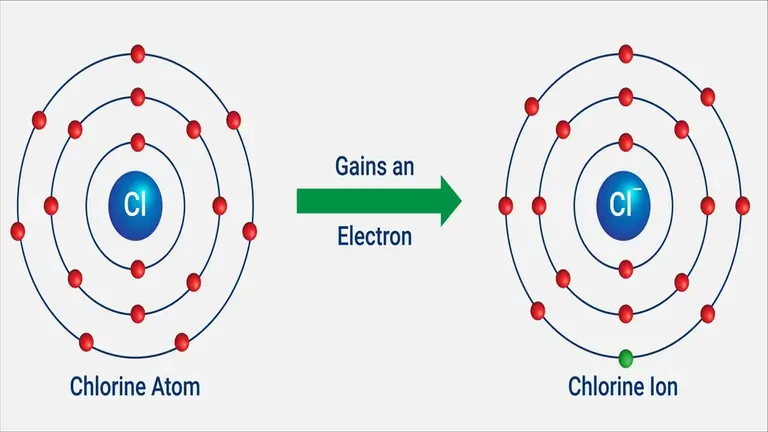Redox reactions consist of two processes, oxidation, and reduction. An atomic exchange of electrons between atoms causes a chemical reaction known as a redox reaction.
The main difference between oxidation and reduction is that oxidation involves an increase of an electron, while reduction involves a decrease of an electron.
Table of Contents
Redox reaction is also known as an oxidation-reduction reaction. In an oxidation-reduction reaction, electrons move between atoms.
Electrons move between atoms. Check out this diagram. Here we got an atom.
A and atom B, and there’s an electron moving out of atom A into atom B.

So, this is definitely an oxidation reduction reaction because there’s an electron moving between the atoms. One atom is losing its electron and another is gaining.
Learn the following definitions below to gain a deeper understanding of these reactions
Oxidation Process

We refer to the process of oxidation, which occurs when anything loses electrons, as the oxidation process.
Something going through an oxidation process is also referred to as a reducing agent in the reaction since a reducing agent donates the electrons.
As oxidation is the loss of electrons.
Example: Zn = Zn2+ +2e-
Reduction Process

An increase in the number of electrons connected to a single or a collection of atoms results from a reduction process. Therefore, an atom that has been reduced will take electrons from other atoms.
An oxidizing agent is a term used to describe a substance going through a reduction, which involves obtaining and accepting electrons.
Thus, the atom that provides the electrons becomes oxidized.
- As electron gain is referred to as reduction.
Example: Cu2+ + 2e- = Cu
Oxidation and Reduction Examples

Think about how zinc metal and hydrochloric acid react.
- ZnCl2(aq) + H2 → Zn(s) + 2 HCl(aq) (g)
If the ions involved in this process were separated out, then:
- Zn2+(aq) + 2 Cl-(aq) + 2 H2 = Zn(s) + 2 H+(aq) + 2 Cl-(aq) (g)
Consider what happens to the zinc atoms first. First, we have a neutral zinc atom. As the process proceeds, the zinc atom loses two electrons, transforming into a Zn2+ ion.
- Zn (s) = Zn2 + (aq) + 2 e-
Zinc underwent oxidation to become Zn2+ ions. An oxidation reaction is taking place here.
The hydrogen ions have a role in the second phase of this process. As they pick up electrons, the hydrogen ions join forces to produce dihydrogen gas.
- 2 H+ + 2 e- → H2(g) (g)
To create the hydrogen gas, which is neutrally charged, each of the hydrogen ions gets an electron. The process is referred to as a reduction reaction because the hydrogen ions are believed to be reduced.
What is the Difference Between Oxidation and Reduction Reactions?
Following are the differences between oxidation and reduction:
1. Oxidation
a. Gain of Oxygen
Oxidation results from an increase in oxygen. Oxidize is the opposite of reduce. Due to its high electronegative nature, oxygen will attempt to free an electron from the atom it is attached to.
b. Increase in Oxidation Number
Oxidation is the word used to describe increment in oxidation number.
c. Electron Loss
Oxidation results from the loss of an electron. This is due to the metal having more protons than electrons if an electron is lost. As a result, both the positive charge and the oxidation state would rise.
2. Reduction
a. Removal of Oxygen
Reduction results from the loss of oxygen. This is due to the fact that the loss of a high electronegative element lowers the oxidation number, which ultimately results in reduction.
b. Reduction in Oxidation Number
Reduction is defined as a decrease in oxidation number.
c. Gain of An Electron
This is also a reduction. This is due to the fact that adding one electron causes a drop in positive charge.
Why Do Oxidation and Reduction Always Occur Together?
A reduced half and an oxidized half, which always occur together, make up redox processes.
While the oxidized half undergoes electron loss and an increase in oxidation number, the reduced half obtains electrons and the oxidation number declines.
This occurs because in order for oxidation to occur, the electrons that are lost by the substance being oxidized must be taken up by atoms or ions of a different substance.
Additionally, in order for reduction to take place, electrons from the atoms of the ions of another material must be transferred into the component that is being reduced.
As a result, oxidation and reduction are reciprocal processes, meaning that one cannot happen without the other.
There are oxidation and reduction reactions everywhere. in the surroundings, in living things, and everywhere we look.
Both of these reactions take place at the same time.
Following are some instances of oxidation-reduction reactions:
The list includes: rusting of iron, corrosion of various metals, photosynthesis, respiration, combustion.
Oxidizing and Reducing Agents

1. Oxidizing Agent
A material that will oxidize another substance is an oxidation agent. Oxidize is basically the opposite of reduce. Other names for oxidizing agents include oxidants and oxidizers. When an oxidizing agent receives electrons from another chemical, oxidation takes place.
The most common oxidizing agents are:
- O2 – Oxygen
- O3 – Ozone
- F2 – Fluorine
- Br2 – Bromine
- H2SO4 – Sulfuric Acid
2. Reducing Agent
A chemical that will reduce another material is a reducing agent
A reducing agent is the opposite of an oxidizing agent. The reducing agent is the thing that donates the electrons.
The most common reducing agents include:
- Na – Sodium
- Mg – Magnesium
- Al – Aluminum
- H2 – Hydrogen
Redox Reaction
A chemical process known as a redox reaction involves simultaneous oxidation and reduction. For instance, water electrolysis is a redox reaction in which the development of hydrogen gas is known as reduction, and the release of oxygen gas is known as oxidation reaction.
- H2O —> H2 + O2
Some of the fundamental processes of life, such as photosynthesis, respiration, and combustion, depend on redox reactions.
Difference Between Oxidation and Reduction Reaction
Highlighting the difference between oxidation and reduction in the following table:
| Oxidation | Reduction |
| Oxidation is the loss of an electron in a chemical reaction. | Reduction is the gain of an electron in a chemical reaction. |
| The electrons are lost in this reaction. | The electrons are gained in this reaction. |
| An oxidizing agent reduces itself after oxidizing different things. Another name for it is an electron acceptor. | In the process of reducing another chemical, a reducing agent oxidizes. Another name for it is an electron donor. |
| Oxidizing agents include sulfuric acid, oxygen and ozone. | Reducing agents include sodium, magnesium and oxalic acid. |
| Positive charges on chemical substances grow as a result of it. | It increases the negative charge on chemical substances. |
Conclusion
The difference between oxidation and reduction is that when electrons are removed is known as oxidation and when they are added is known as reduction. Numerous metabolic pathways, rusting, and burning all depend on these redox reactions (reaction/oxidation). Both oxidation and reduction are components of every redox reaction. As the electrons are transported, one substance is reduced, and the other is oxidized.
Read more: What is the Difference Between Plants and Animals?


